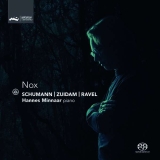 Nox; Robert Schumann: Nachtstücke op. 23; Rob Zuidam: Nox; Maurice Ravel: Gaspard de la Nuit; Leos Janacek: Dobrou noc; Hannes Minnaar, Klavier; 1 SACD Challenge Classic CC72853; Aufnahme 06/2020, Veröffentlichung 25/09/2020 (72'52) - Rezension von Remy Franck
Nox; Robert Schumann: Nachtstücke op. 23; Rob Zuidam: Nox; Maurice Ravel: Gaspard de la Nuit; Leos Janacek: Dobrou noc; Hannes Minnaar, Klavier; 1 SACD Challenge Classic CC72853; Aufnahme 06/2020, Veröffentlichung 25/09/2020 (72'52) - Rezension von Remy Franck
Hannes Minnaar spielt auf dieser Schallplatte ein dramaturgisch gut durchdachtes Programm. Was einem sofort auffällt, ist der persönliche Interpretationsstil des heute 35-jährigen niederländischen Pianisten. So spielt nur ein Interpret mit einer Technik, die es ihm erlaubt, die Musik tiefgründig zu erkunden und poetisch wieder zu geben.
Schumanns Nachtstücke malt er in dunklen Farben. Die Atmung diktiert die Phrasierung und die ganze Klanglichkeit wird in den Dienst des Ausdrucks und der daraus erwachsenden Stimmungen gestellt. Nichts wirkt dabei recherchiert oder manieristisch, alles ist ausgereift und kohärent.
Nox des niederländischen Komponisten Robert Zuidam (*1964) ist ein sehr rezentes Werk, denn sein vierter Satz, ‘Abschied von Reinbert’, bezieht sich auf den Tod des Musikers Reinbert de Leeuw im Februar 2020. Nox ist ein ausdrucksstarkes, rhetorisches Werk, das von Minnaar packend interpretiert wird.
Mit Samtpfoten und wilden Krallen inszeniert Minnaar dann Ravels Gaspard de la Nuit, für das sich der Komponist an den Texten des französischen Romantikers Aloysius Bertrand (1807-1847) inspiriert hat, deren albtraumhaften Charakter er in seiner Musik impressionistisch äußert.
Ondine wird ganz besonders spannend und mit großartigen Farbverläufen gespielt.
Minnaar macht das auf eine sehr suggestive Weise, mit ganz besonderen Pinselstrichen, von den mattesten bis zu den lebendigsten, mit subtilen Abstufungen und echten Farbexplosionen ins Helle wie ins Dunkle.
In Le gibet betrachtet man einen Erhängten am Galgen in der Abenddämmerung. Fünf Fragen stellt das Gedicht zu dem, was man in dieser Szene hören könnte. Die Antwort lautet: « Es ist die Glocke, die an den Mauern einer Stadt unterhalb des Horizonts läutet, und der Leichnam eines Gehängten, der von der untergehenden Sonne gerötet wird. » (C’est la cloche qui tinte aux murs d’une ville, sous l’horizon, et la carcasse d’un pendu que rougit le soleil couchant.) Dies setzt Minnaar mit sehr viel Ruhe um. Erst wenn die Musik aufhört, wird man sich bewusst, was man gerade gehört hat.
Scarbo ist gewiss eines der virtuosesten Stücke der Klavierliteratur, aber Minnaar geht es nicht nur um Virtuosität und den damit zu erzielenden Effekt, es geht ihm um den fantastischen, dämonischen Charakter der Musik, den er auf grandios packende Weise hörbar macht.
On this new Challenge Classics release Hannes Minnaar plays a dramaturgically well thought-out programme. What immediately strikes you is the personal style of interpretation of the now 35-year-old Dutch pianist. His technique allows him to explore the music in depth and render it poetically.
Schumann’s Nachtstücke are played with dark colours. Breathing dictates the phrasing and determines the expression and the moods that arise from it. Nothing seems researched or mannerist, everything is mature and coherent.
Nox by the Dutch composer Robert Zuidam (*1964) is a very recent work, because its fourth movement, ‘Farewell to Reinbert’, refers to the death of the musician Reinbert de Leeuw in February 2020. Nox is a highly expressive, rhetorical work, which is performed by Minnaar in a gripping way.
With velvet paws and wild claws, Minnaar then stages Ravel’s Gaspard de la Nuit, for which the composer was inspired by the texts of the French Romantic Aloysius Bertrand (1807-1847), whose nightmarish character he expresses in his music in an impressionistic way.
With Minnaar, Ondine becomes particularly exciting and suggestive. He plays with very special colours, from the dullest to the most vivid, with subtle gradations and real colour explosions into the light as well as into the dark.
In Le gibet, we see a hanged man on the gallows at dusk. The poem asks five questions about what one might hear in this scene. The answer is: « It is the bell that rings on the walls of a city below the horizon, and the body of a hanged man reddened by the setting sun ». (C’est la cloche qui tinte aux murs d’une ville, sous l’horizon, et la carcasse d’un pendu que rougit le soleil couchant). Minnaar plays with a lot of calm. It is only when the music stops that one becomes aware of what one has just heard.
Scarbo is certainly one of the most virtuosic pieces of piano literature, but Minnaar is not only concerned with virtuosity and the effect that can be achieved with it, he is concerned with the fantastic, demonic character of the music, which he makes audible in a grandiose, gripping way.
























